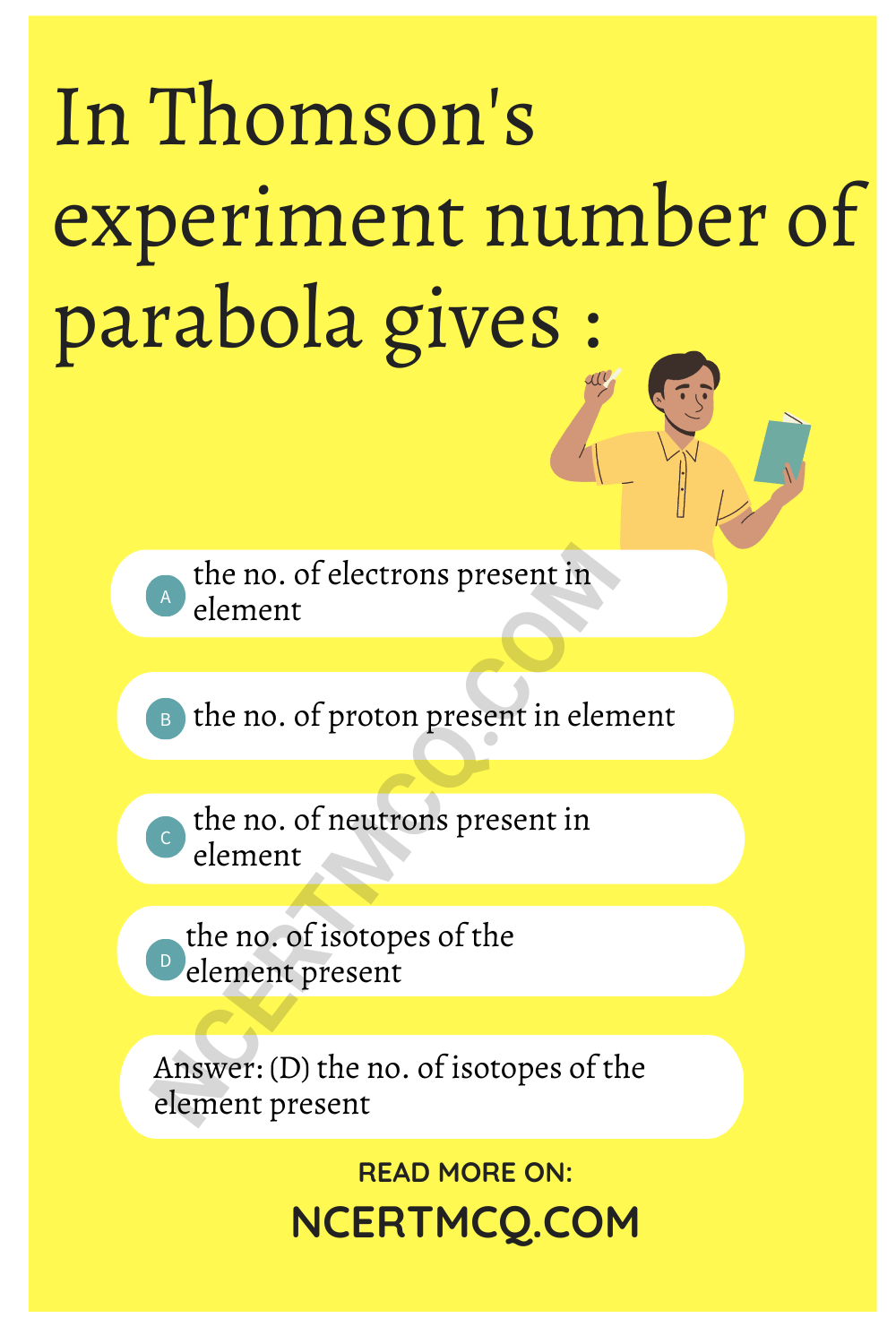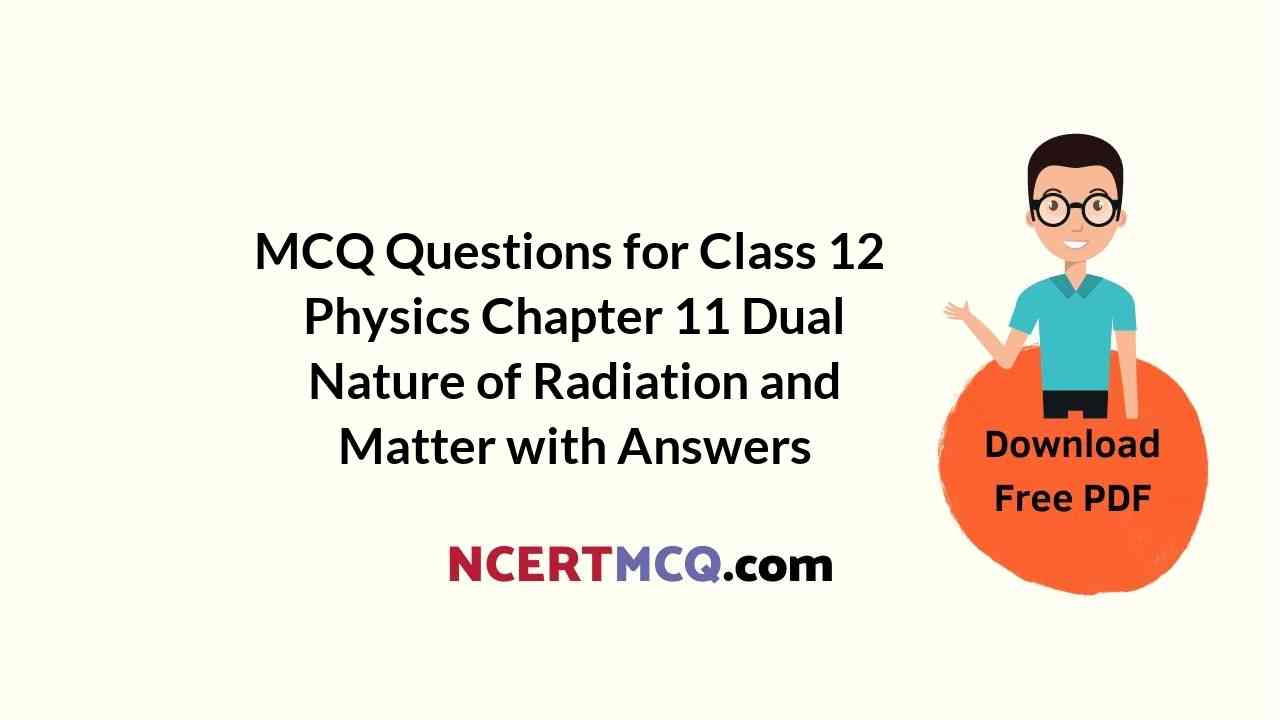Check the below NCERT MCQ Questions for Class 12 Physics Chapter 11 Dual Nature of Radiation and Matter with Answers Pdf free download. MCQ Questions for Class 12 Physics with Answers were prepared based on the latest exam pattern. We have provided Dual Nature of Radiation and Matter Class 12 Physics MCQs Questions with Answers to help students understand the concept very well.
Class 12 Physics Chapter 11 MCQ With Answers
Physics Class 12 Chapter 11 MCQs On Dual Nature of Radiation and Matter
Dual Nature Of Radiation And Matter MCQ Question 1.
De-Broglie equation states the:
(a) dual nature
(b) particle nature
(c) wave nature
(d) none of these
Answer
Answer: (a) dual nature
MCQ On Dual Nature Of Matter And Radiation Question 2.
Protons and alpha particles have the same de-Broglie wavelength. What is same for both of them ?
(a) Energy
(b) Time period
(c) Frequency
(d) Momentum
Answer
Answer: (d) Momentum
Dual Nature Of Radiation And Matter MCQ Questions With Answers Pdf Question 3.
Kinetic energy of emitted electrons depends upon :
(a) frequency
(b) intensity
(c) nature of atmosphere surrounding the electrons
(d) none of these
Answer
Answer: (a) frequency
Dual Nature Of Radiation And Matter MCQ Questions With Answers Pdf Download Question 4.
De-Broglie wavelength of a body of mass m and kinetic energy E is given by (symbols have their usual meanings):
(a) \(\frac{h}{\sqrt{2mE}}\)
(b) \(\frac{h}{2mE}\)
(c) \(\frac{\sqrt{2mE}}{h}\)
(d) \(\frac{h}{mE}\)
Answer
Answer: (a) \(\frac{h}{\sqrt{2mE}}\)
Dual Nature Of Matter And Radiation Class 12 MCQ Question 5.
The ratio of specific charge of an alpha particle to the proton is:
(a) 1 : 2
(b) 2 : 1
(c) 4 : 1
(d) 1 : 4
Answer
Answer: (a) 1 : 2
MCQs On Dual Nature Of Radiation And Matter Question 6.
In Thomson’s experiment number of parabola gives :
(a) the no. of electrons present in element
(b) the no. of proton present in element
(c) the no. of neutrons present in element
(d) the no. of isotopes of the element present
Answer
Answer: (d) the no. of isotopes of the element present

MCQ Of Dual Nature Of Radiation And Matter Question 7.
The work function of photoelectric material is 3.3 eV. The threshold frequency will be equal to:
(a) 8 × 1014 Hz
(b) 8 × 1010 Hz
(c) 5 × 1010 Hz
(d) 4 × 1014 Hz
Answer
Answer: (a) 8 × 1014 Hz
Question 8.
The strength of photoelectric current depends upon :
(a) angle of incident radiation
(b) frequency of incident radiation
(c) intensity of incident radiation
(d) distance between anode and cathode
Answer
Answer: (b) frequency of incident radiation
Question 9.
The momentum of an electron that emits a wavelength of 2 Å. will be:
(a) 6.4 × 10-36 kgms-1
(b) 3.3 × 10-24 kgms-1
(c) 3.3 × 10-34 kgms-1
(d) none of these
Answer
Answer: (b) 3.3 × 10-24 kgms-1
Question 10.
Name the scientists who first studied the passage of electricity through fluids to establish the electrical nature of matter:
(a)Millikan
(b) Planck
(c) Faraday
(d) Boyle
Answer
Answer: (c) Faraday
Question 11.
Millikan’s oil drop experiment makes use of:
(a) Stokes’ law
(b) Boyle’s law
(c) Gas equation
(d) Bernoulli’s theorem
Answer
Answer: (a) Stokes’ law
Question 12.
X-rays are:
(a) deflected by an electric field
(b) deflected by a magnetic field
(c) deflected by both electric and magnetic fields
(d) not deflected by electric and magnetic fields
Answer
Answer: (d) not deflected by electric and magnetic fields
Question 13.
In photo electric emission, for alkali metals the threshold frequency lies in the:
(a) visible region
(b) ultraviolet region
(c) infrared region
(d) far end of the infrared region
Answer
Answer: (a) visible region
Question 14.
Which of the following radiations cannot eject photo electrons?
(a) ultraviolet
(b) infrared
(c) visible
(d) X-rays
Answer
Answer: (b) infrared
Question 15.
What is the de-Broglie wavelength of an electron accelerated from rest through a potential difference of V volts?
(a) \(\frac{12.3}{V^2}\) Å
(b) \(\frac{12.3}{V}\) Å
(c) \(\frac{12.2}{V^2}\) Å
(d) None of these
Answer
Answer: (a) \(\frac{12.3}{V^2}\) Å
Question 16.
What is the de-Broglie wavelength of an electron accelerated from rest through a potential difference of 100 volts?
(a) 12.3 Å
(b) 1.23 Å
(c) 0.123 Å
(d) None of these
Answer
Answer: (b) 1.23 Å
Question 17.
What is the de-Broglie wavelength of a proton accelerated from rest through a potential difference of V volts?
(a) \(\frac{12.3}{√V}\) Å
(b) \(\frac{12.3}{V}\) Å
(c) \(\frac{12.2}{V^2}\) Å
(d) None of these
Answer
Answer: (d) None of these
Question 18.
When a yellow light is incident on a surface, no electrons are emitted while green light can emit electrons. If the red light is incident on the surface then:
(a) no electrons are emitted
(b) photons are emitted
(c) electrons of higher energy are emitted
(d) electrons of lower energy are emitted
Answer
Answer: (a) no electrons are emitted
Question 19.
The de-Broglie wavelength of particle of mass 1 mg moving with a velocity of 1 ms-1, in terms of Planck’s constant h, is given by (in metre):
(a) 105 h
(b) 106 h
(c) 10-3 h
(d) 103 h
Answer
Answer: (b) 106 h
Question 20.
Evidence of the wave nature of light cannot be obtained from:
(a) diffraction
(b) interference
(c) doppler effect
(d) reflection
Answer
Answer: (d) reflection
Question 21.
which Characteristic of a target does the Mosley’s law relate the frequency of X-rays?
(a) density
(b) atomic number
(c) atomic weight
(d) interatomic space
Answer
Answer: (b) atomic number
Question 22.
The charge of a photo electron is :
(a) 9.1 × 10-31 C
(b) 9.1 × 10-27 C
(c) 9.1 × 10-24 C
(d) none of these
Answer
Answer: (d) none of these
Question 23.
The number of photons of frequency n present in energy E, in terms of Planck’s constant h:
(a) \(\frac{E}{nh}\)
(b) nhE
(c) \(\frac{nh}{E}\)
(d) \(\frac{nE}{h}\)
Answer
Answer: (a) \(\frac{E}{nh}\)
Question 24.
Compared to liquids and solids, gases are:
(a) good conductors of electricity
(b) best conductors of electricity
(c) very poor conductors of electricity
(d) good or bad conductors of electricity depending upon the nature of the gas
Answer
Answer: (c) very poor conductors of electricity

Question 25.
The different stages of discharge in a discharge tube can be explained on the basis of:
(a) the wave nature of light
(b) the dual nature of light
(c) wave nature of electrons
(d) the collision between the charged particles emitted from the cathode the atoms of the gas in the tube
Answer
Answer: (d) the collision between the charged particles emitted from the cathode the atoms of the gas in the tube
Question 26.
When an electron jumps across a potential difference of 1 V, it gains energy equal to :
(a) 1.602 × 10-19 J
(b) 1.602 × 1019 J
(c) 1.602 × 1024 J
(d) 1 J
Answer
Answer: (a) 1.602 × 10-19 J
We hope the given NCERT MCQ Questions for Class 12 Physics Chapter 11 Dual Nature of Radiation and Matter with Answers Pdf free download will help you. If you have any queries regarding Dual Nature of Radiation and Matter CBSE Class 12 Physics MCQs Multiple Choice Questions with Answers, drop a comment below and we will get back to you soon.
Class 12 Physics MCQ:
- Electric Charges and Fields Class 12 MCQ
- Electrostatic Potential and Capacitance Class 12 MCQ
- Current Electricity Class 12 MCQ
- Moving Charges and Magnetism Class 12 MCQ
- Magnetism and Matter Class 12 MCQ
- Electromagnetic Induction Class 12 MCQ
- Alternating Current Class 12 MCQ
- Electromagnetic Waves Class 12 MCQ
- Ray Optics and Optical Instruments Class 12 MCQ
- Wave Optics Class 12 MCQ
- Dual Nature of Radiation and Matter Class 12 MCQ
- Atoms Class 12 MCQ
- Nuclei Class 12 MCQ
- Semiconductor Electronics: Materials, Devices and Simple Circuits Class 12 MCQ
- Communication Systems Class 12 MCQ
